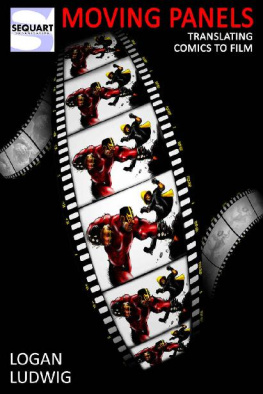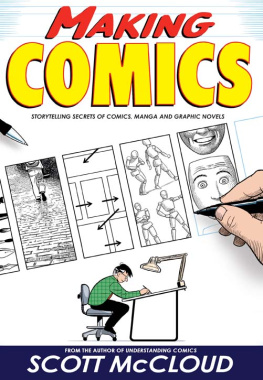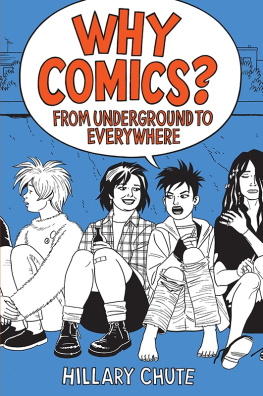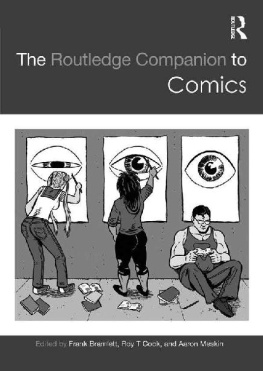Copyright 2015 by Logan Ludwig. Characters and works mentioned herein are trademarked by various owners.
Kindle edition, February 2015.
All rights reserved. Except for brief excerpts used for review or scholarly purposes, no part of this book may be reproduced in any manner whatsoever, including electronic, without express consent of the publisher.
Cover by Jeffrey Vincent Stong. Book design by Julian Darius. Interior art is their respective owners.
Published by Sequart Organization. Edited by Hannah Means-Shannon. Assistant edited by Stuart Warren, Glen Downey, Julian Darius, and Mike Phillips. Thanks to Alyssa Warren, Nicolas Labarre, Henry Northmore, Chris Rywalt, M. S. Wilson, and Patrick Wilson.
For information about other titles in this series, visit sequart.org/books .
Previously
The film industry cant seem to stop adapting comic books. Studios are hooked on trying to find the next big franchise, and comics seem to be their current bet for box office success. Whether its long-running series featuring characters such as Batman or Spider-Man, new comic properties, or even comics that havent been released yet (for instance, the film version of Kick-Ass was in production before the comic had wrapped its first mini-series), sequential storytelling offers filmmakers a well of ideas ready-made for translation to the big screen. The trend doesnt seem likely to slow down, and the film industry will continue scouring the comic world for more material for years to come.
Not only is Hollywood taking comic properties and turning them into films, but theres also a growing trend of creators crossing from one medium to the other. Writer-directors like Joss Whedon are dabbling in comics more frequently, while also taking charge of cinematic mega-properties such as The Avengers . Conversely, comic creators like Mark Millar are being brought in by studios such as 20 th Century-Fox to oversee their comic-book adaptations. Because of this, its important to ask ourselves how closely related the two media are and just how easy it is to move from comics to film. But are comics as natural a fit for translation to the screen as Hollywood seems to believe?
This book examines how disparate these two media are, proving that comics are more than storyboards for films without budgets. Each medium possess unique qualities in terms of its storytelling capabilities, but the two are also similar in form. Neither is better, neither is worse. Each simply operates by certain rules that shape how the creator approaches the project. Creators moving from one of these media to the other might have a slight advantage over other creators, but any such move requires the creator to adapt to their new mediumto learn new and varied techniques so they can tell their stories in the most effective fashion possible.
In examining the relationship between these two forms of media, its useful to focus on adaptation, in which the same story is told in both media. The differences in these tellings often reflect the differences between the media themselves, and by examining these adaptations we may come to better understand the differences between comics and film.
Fidelity and Watchmen
This raises an important issue: the notion of fidelity. For the purposes of this book, fidelity will mean creating equivalent, rather than identical, effects across the different media. Fidelity is not a literal translation of images and content, which is always adapted. Current attitudes toward adapting comics to film tend to privilege superficial forms of fidelity. One need only look at the film version of Watchmen , one of the most important comics of all time.
In the words of Jeffrey Dean Morgan, the actor who portrays the Comedian in the film: Its so true to the book I can't even begin to tell you how. Everything is so true to the book its insane. You can put anything that has been built for Watchmen next to a panel in the book and itll trip you out. Its amazing. While Morgans assessment may be correct (the movie does emulate the comics look), it misses a crucial reason why the original work looked the way it did. Alan Moore and Dave Gibbons designed Watchmen to evoke classic comic-book aesthetics, so their choices for the books design, such as color, built upon the visual history of comics. Watchmen was a book built on the history of the medium and, for readers steeped in comics, this creates a subtext for the work that comments on the story and its relation to other stories that preceded it. When the film version of Watchmen copies this visual style exactly, this comics-specific subtext breaks down. Mainstream filmgoers are not expected to have a working knowledge of the history of comic-book aesthetics. Because of this decision to be faithful to the original work, the films direction interferes with the intent and purpose of Moores design.
Couldnt the film have replicated aesthetic traditions from previous film adaptations of super-hero comics? While some attempts have been made to accomplish this (e.g. the rubbery costume redesigns evoke some 90s super-hero films such as Joel Schumachers Batman and Robin ), the movie is largely content with reproducing the original work on the screen. Watchmen , on the other hand, draws on a variety of aesthetic and storytelling norms that have been built up over decades of comics and their history rather than just the relatively small footprint of comic-book films. Moore and Gibbonss Watchmen is more than just a simple story: its a commentary on the medium as a whole. Adapting this material to a different medium can feel essentially pointless. Brian K. Vaughan, a writer who works in comics, television, and film, put it simply: it's like making a stage play of Citizen Kane . I guess it could be OK, but why? The medium is the message. The film ends up failing simply because it is too slavishly faithful to its source, and in doing so it loses sight of what made the original comic so provocative and effective.
Admittedly, Watchmen is an extreme example, and its quite rare for any work to be so strongly tied to its original medium. Still, its a useful case study because it helps highlight the issue that no matter how close two media may seem, they are inevitably unique in both their storytelling capacities and their aesthetic histories. Adapting Watchmen is a thankless task, because the story and its meaning are inherently tied to comics as a medium.
Ill explore Watchmen specifically in a later chapter. For the moment, its useful to step back and deal with some larger, more theoretical issues.
Understanding Comics Adaptation
Id now like to look into the issue of adapting material between media. I intend to deploy a variety of case studies to help explain how comics and films function and what similarities and differences arise when telling stories. These case studies will be wide-ranging and focus on a variety of topics and works, from the mainstream super-hero stories featured in Iron Man and The Invincible Iron Man to the autobiographical comic and film versions of Marjane Satrapis Persepolis . These aesthetic studies will help us focus on some of the unique capabilities of comics and films and make a strong case for recognizing comics as a singular medium with capabilities unlike any other.
We must take a step back and look at the scholarly work that already exists in relation to comics. Much has been written about film and its aesthetic qualities, but when it comes to comics there is a much smaller body of work to dig into. There are how-to books and histories of comics, but there is significantly less writing devoted to serious aesthetic discussions of comics. We must establish a base from which to work before heading further. By and large, current comic-book criticism deals with comic content as opposed to the form. While there are many critics who understand how comics function, this is of less interest to those interpreting what comics mean in a more traditional, literary sense. Symbolism and metaphors have come to the front in many critical essays, but still, a more robust formal discussion of aesthetics demands inquiry.








